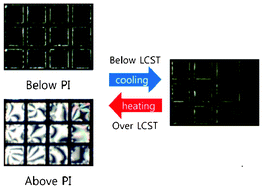The homeotropic to planar orientational change (H–P change) at the interface between 4-cyano-4́-pentylbiphenyl (5CB) and water in the transmission electron microscopy (TEM) grid cell functionalized by decoration of an amphiphilic block copolymer of PNIPAM-b-LCP (PNIPAM; poly(N-isopropyl acrylamide) and LCP; poly(4-cyanobiphenyl-4-oxyundecylacrylate) was used to detect proteins with variations of pH and temperature in the cell. Several proteins including lysozyme, bovine serum albumin, hemoglobin and chymotrypsinogen were detected at levels of a few μM to hundreds of nM through a homeotropic to planar orientational change (H–P change) of 5CB at above the low critical solution temperature (LCST) of PNIPAM and below the pH of PI of the protein. The H–P change through protein adsorption was reversible by changing the temperature above and below PNIPAM's LCST. This TEM grid cell could also detect the proteins in human urine from a patient with albuminuria with a detection limit as low as 5.88 × 10−5 wt%.

